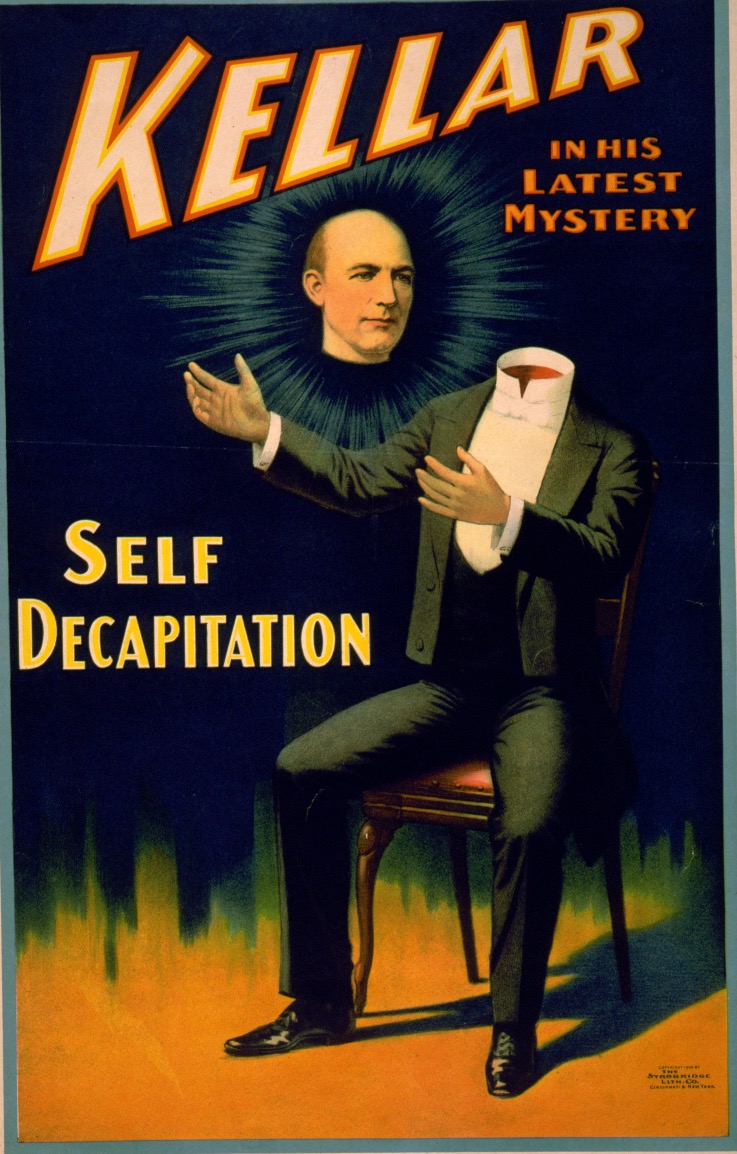“Up to the present time everything that I have investigated has been the result of deluded brains”
– Harry Houdini
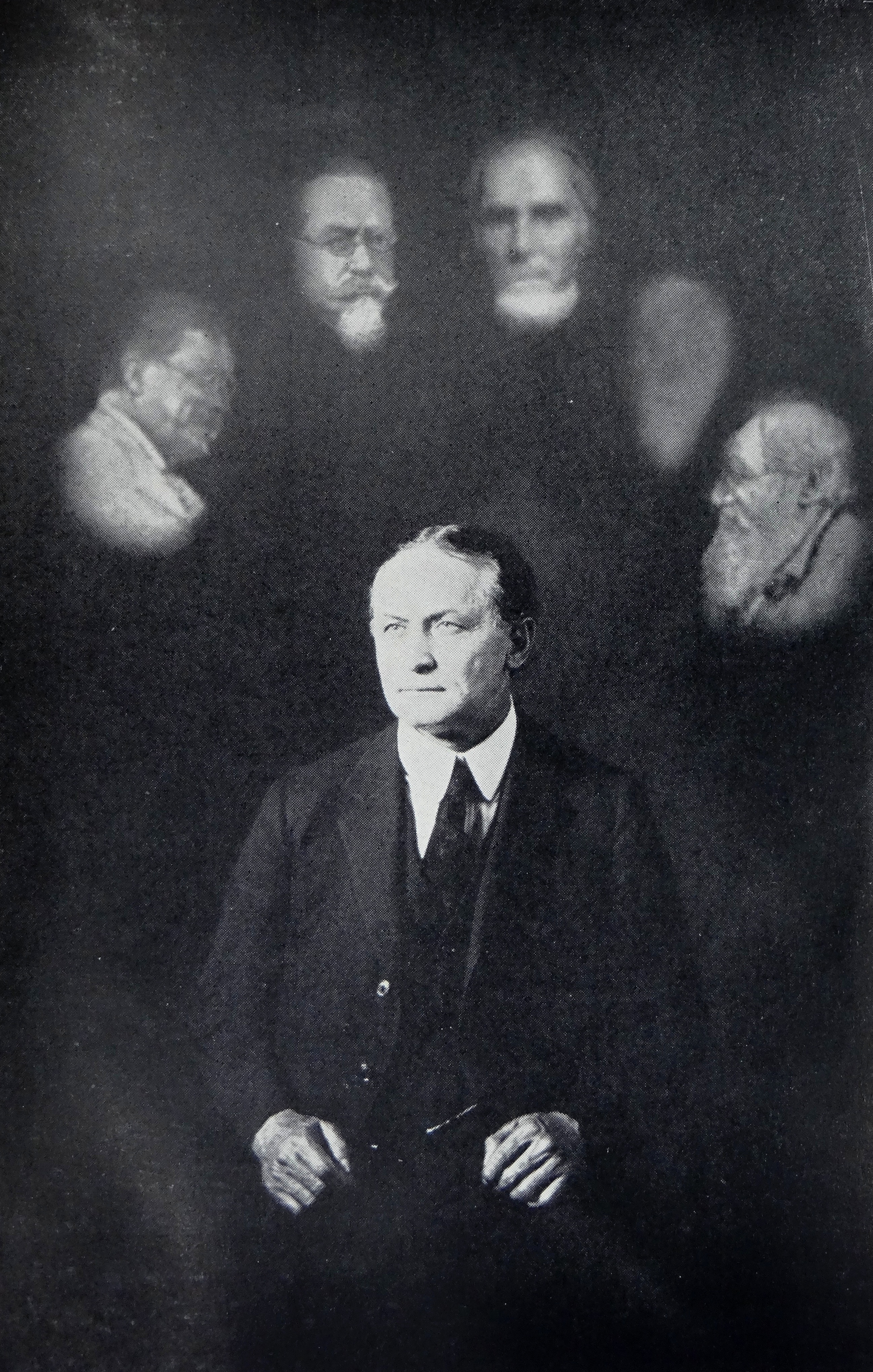
Spirit Photograph by Alexander Martin in Harry Houdini’s book “A Magician Among the Spirits” (1924)
Harry Houdini (1874-1926), the great showman and escapologist, sought to debunk the 1920s fashion for spiritualism in his book A Magician Among The Spirits (1924). He wanted to believe, stating in the book’s preface: “Gladly would I embrace Spiritualism if it could prove its claims, but I am not willing to be deluded by the fraudulent impositions of so-called psychics, or accept as sacred reality any of the evidence that has been placed before me thus far.” But conjuring fakirs who bamboozled the credulous” were plentiful in the years after World War 1, not least of all in the shape of American chancer Henry Slade.
During his séances, Slade would place a small slate with a piece of chalk under a table and claim spirits would use it to write messages Houdini mentions Slade’s work explicitly in the chapter VI “DR. SLADE AND HIS SPIRIT SLATES”. Endorsed by Theosophists Madame Helena P. Blavatsky, Slade made a mint in New York City before rocking up in London via a stint at Imperial University of St. Petersburg under the authority of the Grand Duke Constantine of Russia as a medium expert in psychic investigation. In London, the self-styled doctor earned another fortune in quick time offering communication with the dearly departed.
And then his scam became as transparent as the ghosts he conjured.
At Bow Street court, magician J. N. Maskelyne performed all of Slade’s tricks in the witness box. Slade was convicted and sentenced to three months at hard labor for earning money under false pretences. An appeal was taken and the decision quashed on account of a procedural flaw. As prosecutors sorted out the paperwork, Slade legged it to Germany, where he earned a living performing the same con.
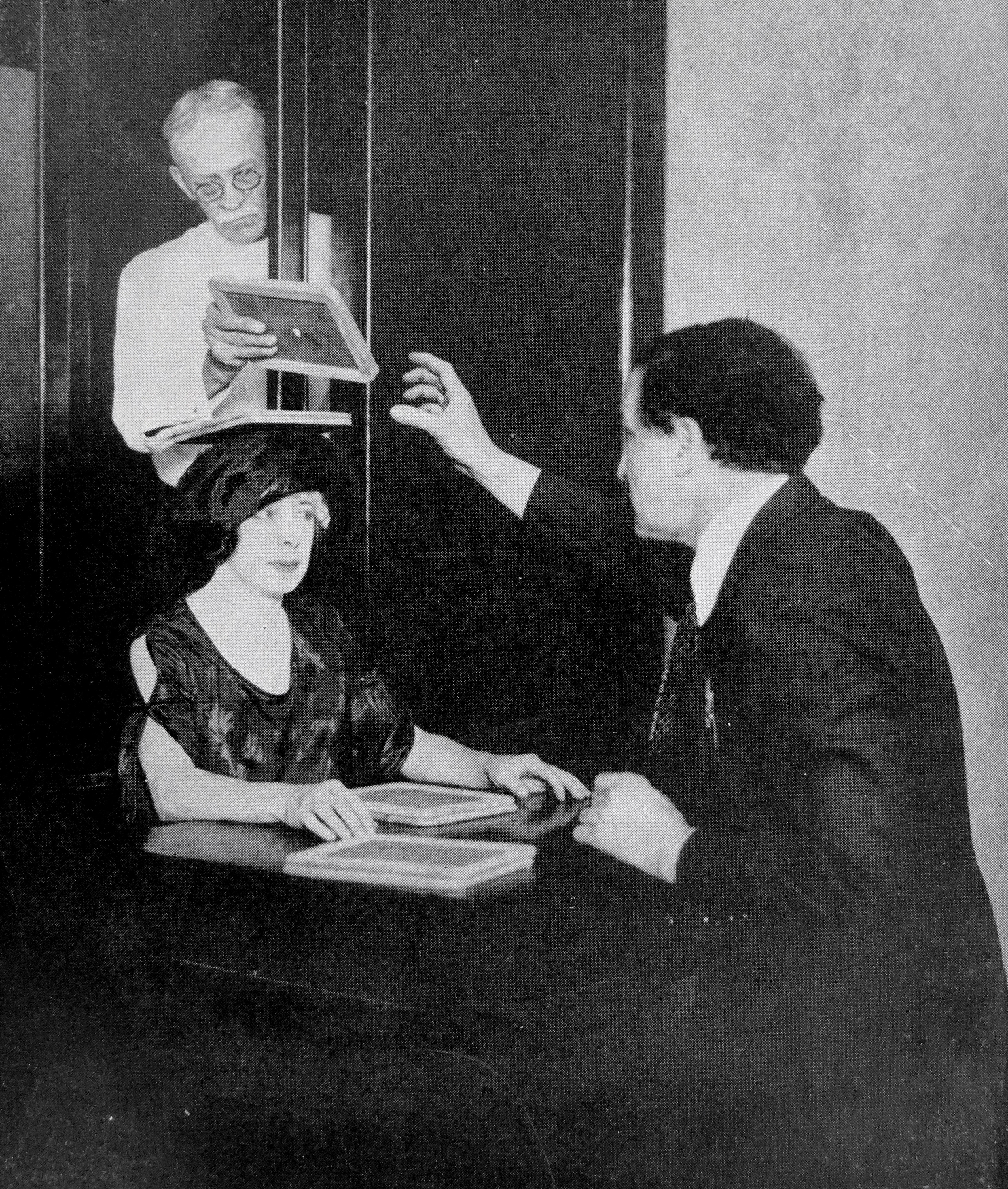
Slate-switching deception demonstrated by Harry Houdini in his book “A Magician Among the Spirits” (1924)
Houdini explains Slade’s undoing – the trap and its execution:
While touring Europe in 1920 I had the pleasure of meeting Sir Ray Lankester and hearing from him an account of Dr. Slade’s undoing. Both he and Dr. Horatio Donkin were physicians. They had been laying their plans to expose two other mediums, Herne and Williams, but Slade’s unexpected arrival in London changed these plans and instead they plotted the seance which proved to be Slade’s downfall.
Donkin was away from London at the time but Sir Lankester wired him and while waiting for his return attended one of Slade’s seances. He pretended to Slade that he came to see if the Spirits would write a message on the slates if he held them himself. Slade assured him that they would and arrangements were made for a second sitting. Before Sir Lankester left Slade asked him if he had been in communication with any departed relatives.
“No, but I have an Uncle John,” Sir Lankester replied.
Consequently at the second sitting the following message was received:
“I am glad to see you here again John.”
“But have you an Uncle John?” I asked.
“No, Houdini,” he replied smiling, “that is why everyone laughed in the courtroom at the time of the trial.
You see, Slade thought I was a firm believer, and I allowed him to distract my attention. He said to me ‘You have a great deal of mediumistic power about you. I see them over you behind your head.’ ”
As he said this Sir Lankester raised his head with seeming credulity acting the part splendidly.
“What made you suspect Slade?” I asked him.
“At the first seance I noticed the tendons move on Slade’s wrist as he held his hand outstretched under the table,” Sir Lankester replied, “and while making a number of suspicious moves he scratched the slates a number of times with his finger nail to simulate the noise made by a slate pencil when writing on a slate.”On the return of Sir Donkin it was arranged that he and Sir Lankester should attend a seance together and that Sir Donkin was to watch for the “suspicious move” and when he saw it signal Sir Lankester. Everything worked as planned. On receiving the agreed signal from Donkin, Lankester seized the slate containing the finished message proving that a skilful exchange of slates had been made by Slade and this was the real evidence which caused the downfall 0f Henry Slade in England.
And there was more. The Seybert Commission for Investigating Modern Spiritualism, a group named after its found Henry Seybert and consisting of faculty members at the University of Pennsylvania, investigated a number of respected spiritualist mediums, uncovering fraud or suspected fraud in every case that they examined. They hired the esteemed magician Henry Kellar to show them Slade’s slate writing. Kellar told the skeptics to bring their own slates.
[They] all sat down around the table with hands resting, palm down, on its top. The Commission opened the sitting by writing questions on the slates. Kellar held them under the table with the thumb on top and when he withdrew them in a few moments they had answers to the questions written in a clear round hand. The questions gradually became longer and longer, but the replies kept pace with them, sometimes covering a whole side of the slate. Although the slates were all different and could not possibly be mistaken for one another. the Commission began to put identifying marks on them.
Once no pencil was put on the top of the slate but the reply came just the same. This fact was commented upon and Kellar replied: “Oh, my Spirits can write without pencils,” a statement which puzzled the members of the Commission all the more. Finally the magician asked them to write a question on a slate’ and cover it with another, placing the pencil between the two. Even this did not bother the “Spirits,” for when the slates were returned, both sides were found covered with writing.
Harry Houdini harks back to the Commissions report on Kellar’s performance:
An eminent professional juggler performed, in the presence of three of our Commission, some independent slate-writing far more remarkable than any of which we have witnessed with mediums. In broad daylight, a slate perfectly clean on both sides, was, with a small fragment of slate pencil, held under a leaf of a small, ordinary table, around which we were seated; the fingers of the juggler’s hand pressed the slate tight against the underside of the leaf, while the thumb completed the pressure and remained in full view clasping the leaf of the table. Our eyes never for the fraction of a second lost sight of that thumb; it never moved; and yet in a few minutes the slate was produced, covered with writing. Messages were there, and still are there, for we preserved the slate, written in French, Spanish, Dutch, Chinese, Japanese, Gujorati, and ending with ‘ich bin ein Geist, und lieb, mein Lagerbier.’ For one of our number the juggler subsequently repeated the trick and revealed its every detail.
The method which Kellar used, and which he described to me, was this. With the consent of the owner of the hotel, whom he agreed to pay for any damage, he had a small trap made in the floor of the room, about as large as a hot air register, with the necessary means of opening and closing it. A plush rug with rectangular designs was placed over this trap, and one of the designs, which was just the size of the trap, was cut out with a razor, these cuts being imperceptible. The piece of rug was glued firmly to the top of the trap. In addition to these preparations, Kellar bought a specimen of every variety of slate to be found in the downtown section of Philadelphia.
When the time for the “seance” arrived, Barney, Kellar’s clever young assistant, was seated on a platform in the room underneath the trap with the assortment of slates by his side. As soon as the Commission was seated around the table he opened the trap and could then hear all that was said in the room above. When the exhibition commenced he simply took the slate Kellar put under the table leaf, selected one from his assortment to match it, wrote on it the answer, and then slipped it under Kellar’s fingers. In the case of a marked slate he used that instead of a duplicate. Of course it was perfectly easy for Kellar to do his part without removing his thumb from the top of the table. “A fake, pure and simple, you will say,” Kellar remarked to me, and then added, “but that’s what all Spiritualistic manifestations are.”
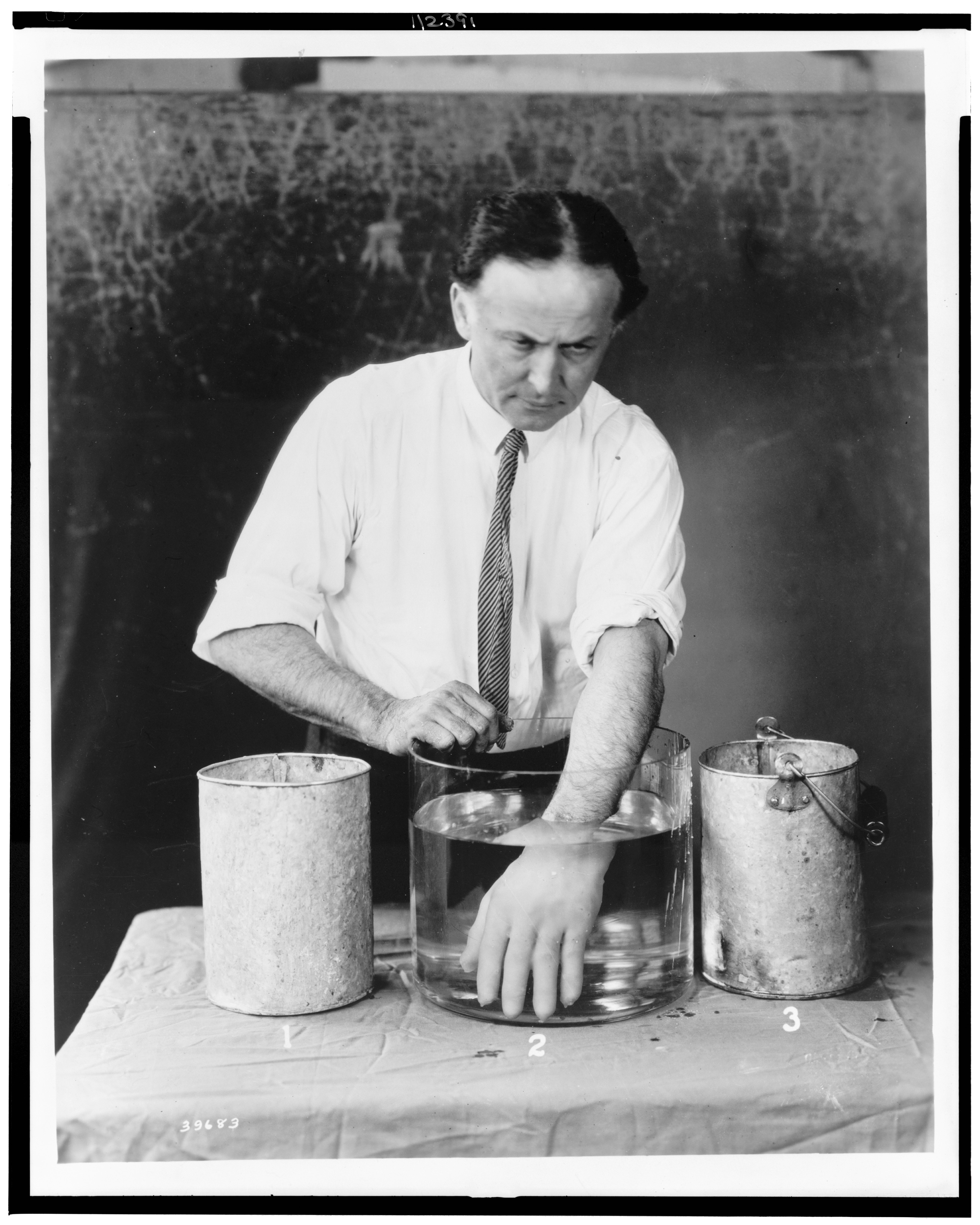
A Magician Among The Spirits was published in conjunction with a number of photographs and experiments, including this sequence of photographs (above and three below) in which Houdini demonstrates how spirit hands that appeared at seances were made by less ethereal beings. Houdini describes the mediumistic fraud known as “finger-printing a spirit”. A mould of a dead person’s hand would be carefully prepared and, during a seance, fingerprints of the deceased would appear on a lamp blacked trumpet. Houdini tells readers: “There are two cases on record where fortunes were at stake because of this sort of fraud. In one case five hundred thousand dollars changed hands upon the recognition of the finger prints of a man who had died two years before.”
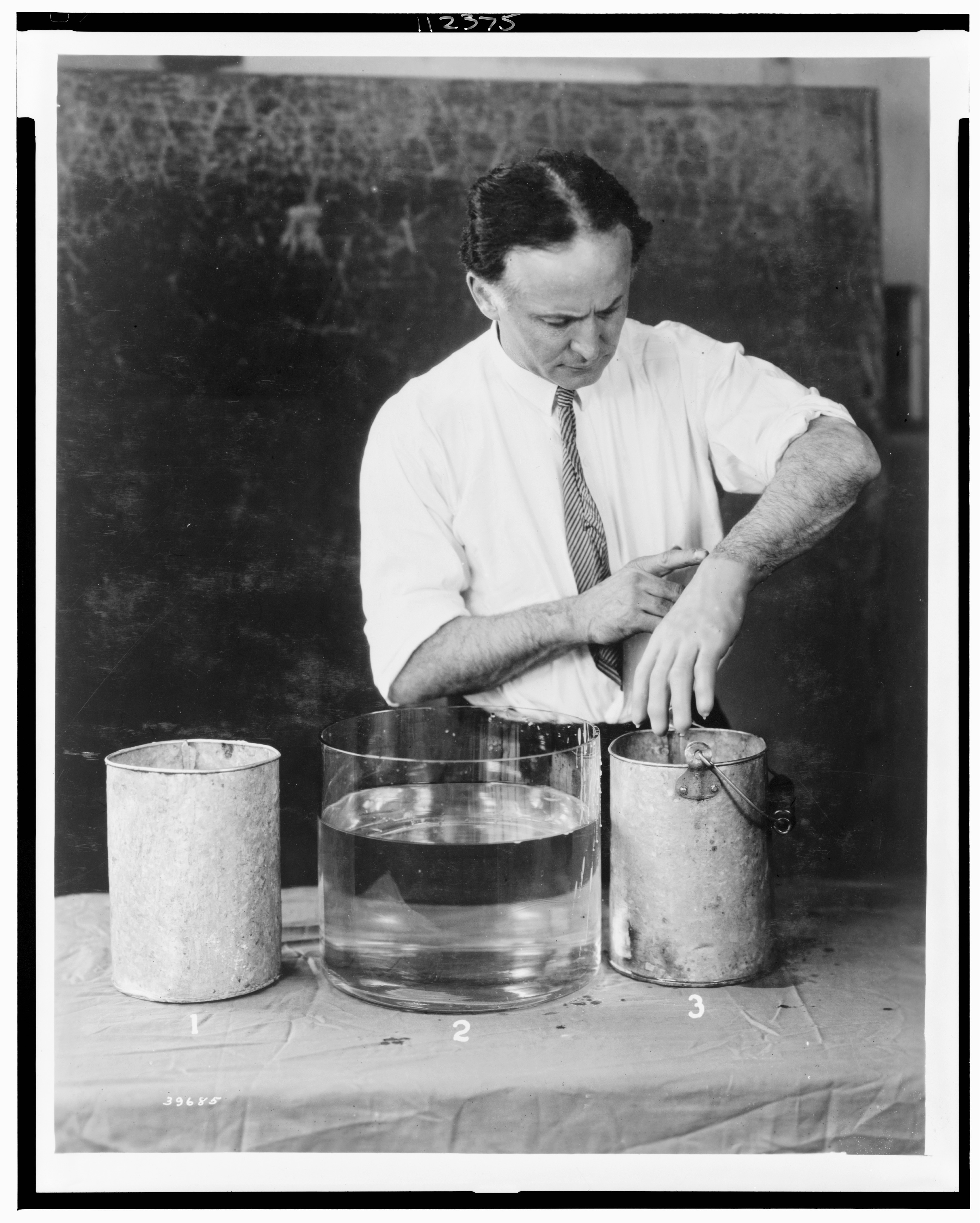
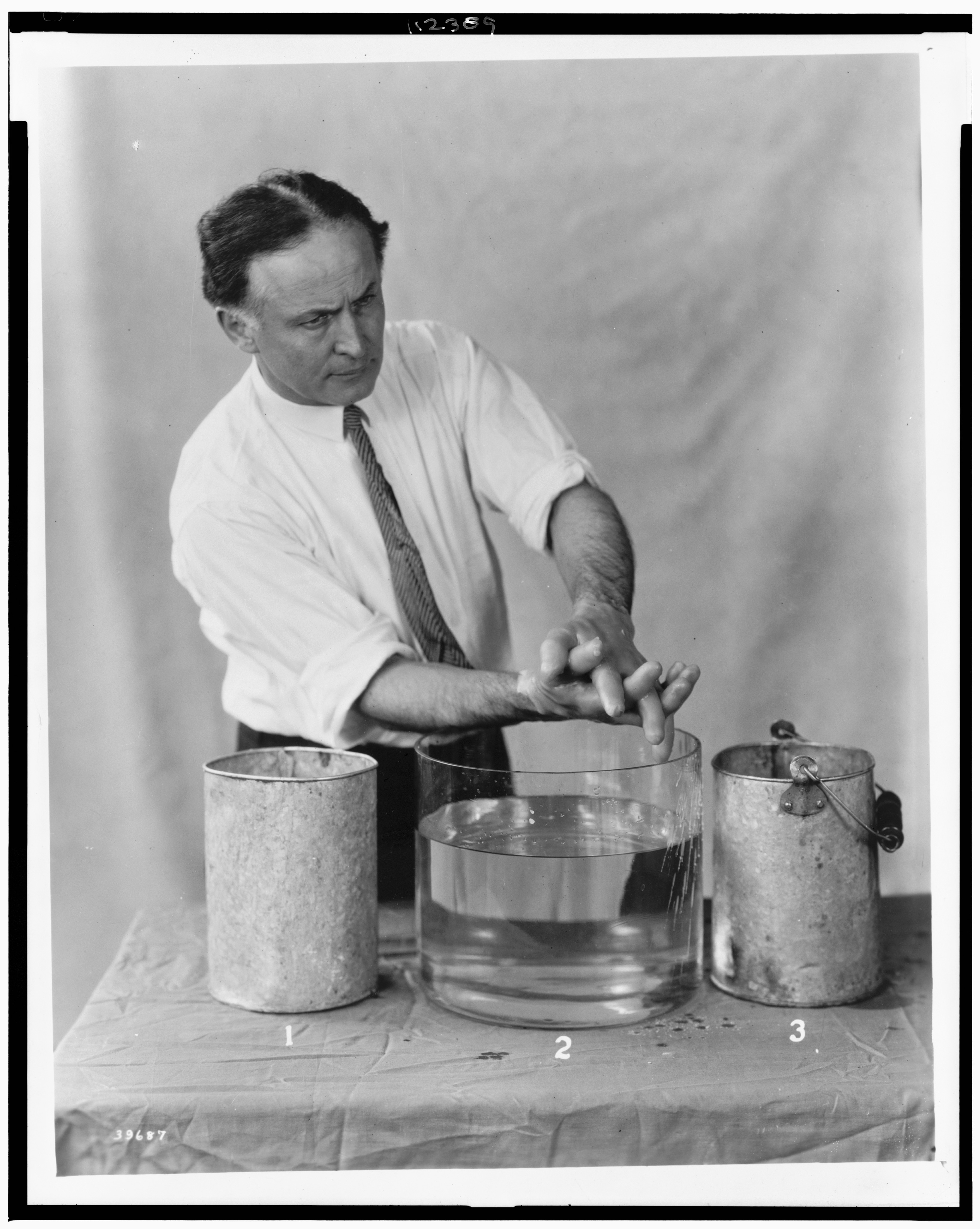
Harry Houdini:
One of the most startling swindles I ever heard of a medium working was called “finger-printing a Spirit.” In this test the medium shows the sitter finger prints of the departed soul. I hesitated at first about including this fake, fearing to add to the stock of unscrupulous mediums but I finally concluded that the public should know about it. The scheme was first discovered by a sculptor who dabbled some in Spiritualism.
“One day, several years ago, a workman fell from the top of the building, in which this man had his studio, and was killed. The body was carried into the studio and while alone with it the sculptor conceived the idea of fooling some guests who were to hold a seance that night. He hurriedly made a plaster of Paris mould of the dead man’s fingers and later filled it with a rubber-like substance used in his work. When this had hardened and the plaster had been removed it resembled, even to the most minute detail, the dead hand.
“During the seance that night he produced finger prints with it on a trumpet which he had lampblacked and upon investigation it was found that these finger prints corresponded exactly with those of the man in the morgue. No one was able to explain the mystery and he kept the secret for some time but later another medium learned it and obtained a position in an undertaking establishment where he found an opportunity after a while to secure the finger prints of several of the dead who belonged to the wealthy class. In due time he arranged seances with the relatives and convinced them of his genuineness. There are two cases on record where fortunes were at stake because of this sort of fraud. In one case five hundred thousand dollars changed hands upon
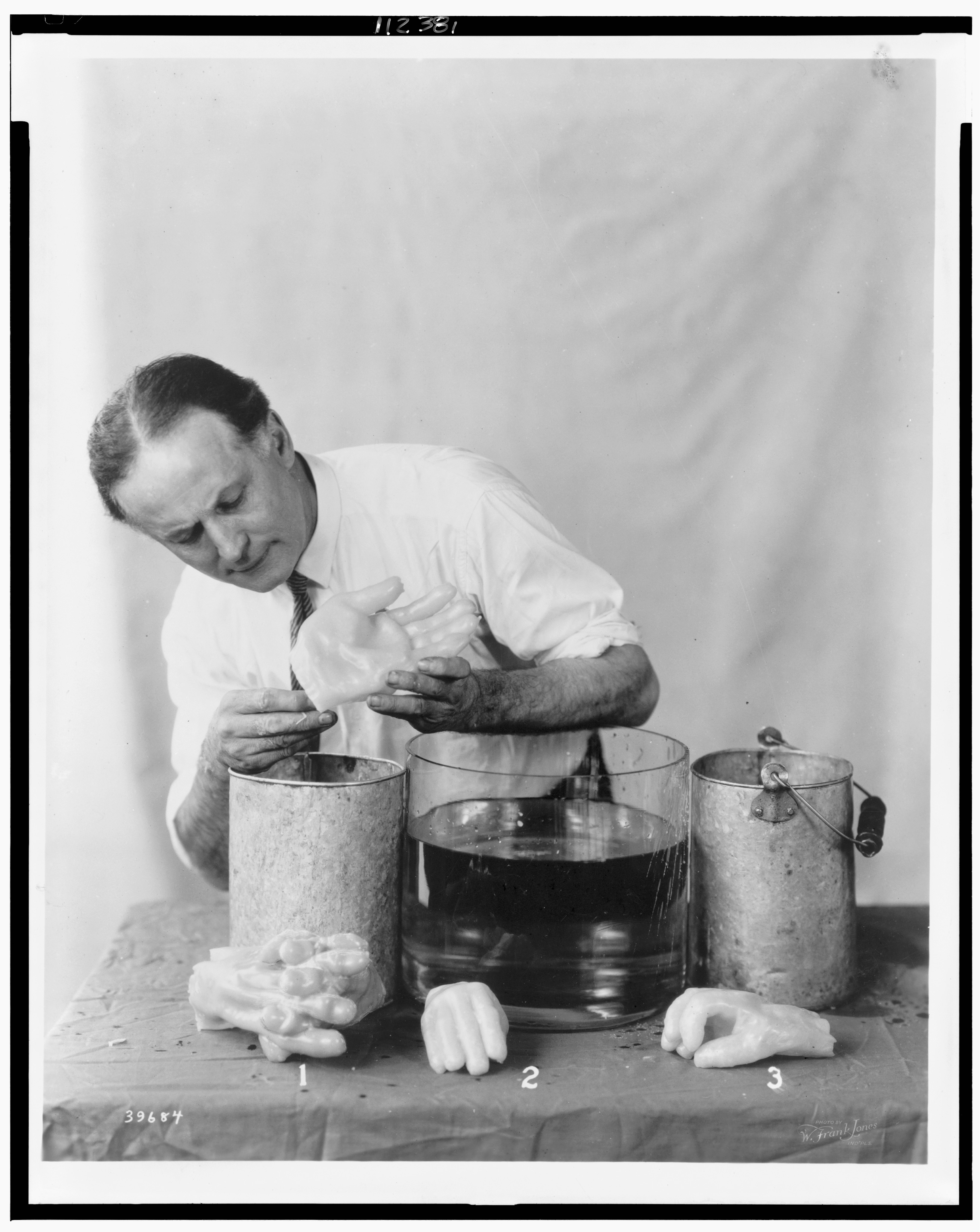
It’s worthwhile looking at the Introduction to the book, not least of all because hearing Houdini is something new for those of us who have seen him only in posters and silent films. And like all goof showmen, he introduces us to his showbiz pals.
A memorable incident in my life and one that shows how little the world at large understands the methods by which my mysteries are produced and also shows how easy it is for even a great intellect, faced with a mystery it cannot fathom, to conclude that there is something supernatural involved, has to do with Madame Sarah Bernhardt.
During one of my various engagements in Paris she had witnessed my performances and was anxious to see one of my outdoor exploits, so, when we were both at the same time in Boston, out of good camaraderie I gave a special performance at my hotel adding a few extra experiments for her benefit. As we were seated in the motor car on the way to my demonstration
she placed her arm gently around my shoulder, and in that wonderful speaking voice with which she was gifted and which has thrilled thousands of auditors, but now stilled forever, she said to me:
“Houdini, you do such marvellous things. Couldn’t you–could you bring back my leg for me?”
I looked at her, startled, and failing to see any mischievous sparkle in her eye replied:
“Good heavens, Madame, certainly not; you cannot be serious. You know my powers are limited and you are
actually asking me to do the impossible.”
“Yes,” she said as she leaned closer to me, “but you do the impossible.”
We looked at each other; she, the travel-worn, experienced woman of the world; I, the humble mystifier, nonplussed and thunderstruck at the extraordinary, unintentional compliment she was paying me. Then I asked:
“Are you jesting?”
“Mais noli, Houdini, j’ai jamais ete plus serieux dans ma vie,” she answered as she slowly shook her head.
“Madame, you exaggerate my ability,” I told her. Each of the marvels of modern scientific achievement such as the telephone, radio, flying machine, radium, etc., were at one time classed as impossible and would have been looked upon as supernatural, if not Spiritual manifestations. Similar mysteries, but more frail in principle and constructive detail, were the instruments used by the priestcraft of ancient religious cults for the purpose of holding the mass of unintelligent beings in servitude. It is not unusual for the eye or ear to play tricks with tine but when such illusions and delusions are taken for the Spirit forms of the departed and voices of the dead instead of being recognized as some subjective phenomena brought about by a physical cause the situation takes on a grave aspect. It is this transfer of an inner reaction to an external object which constitutes practically all that is necessary to be placed in the category of “psychics”, who represent the priests and ministers of Spiritualism.
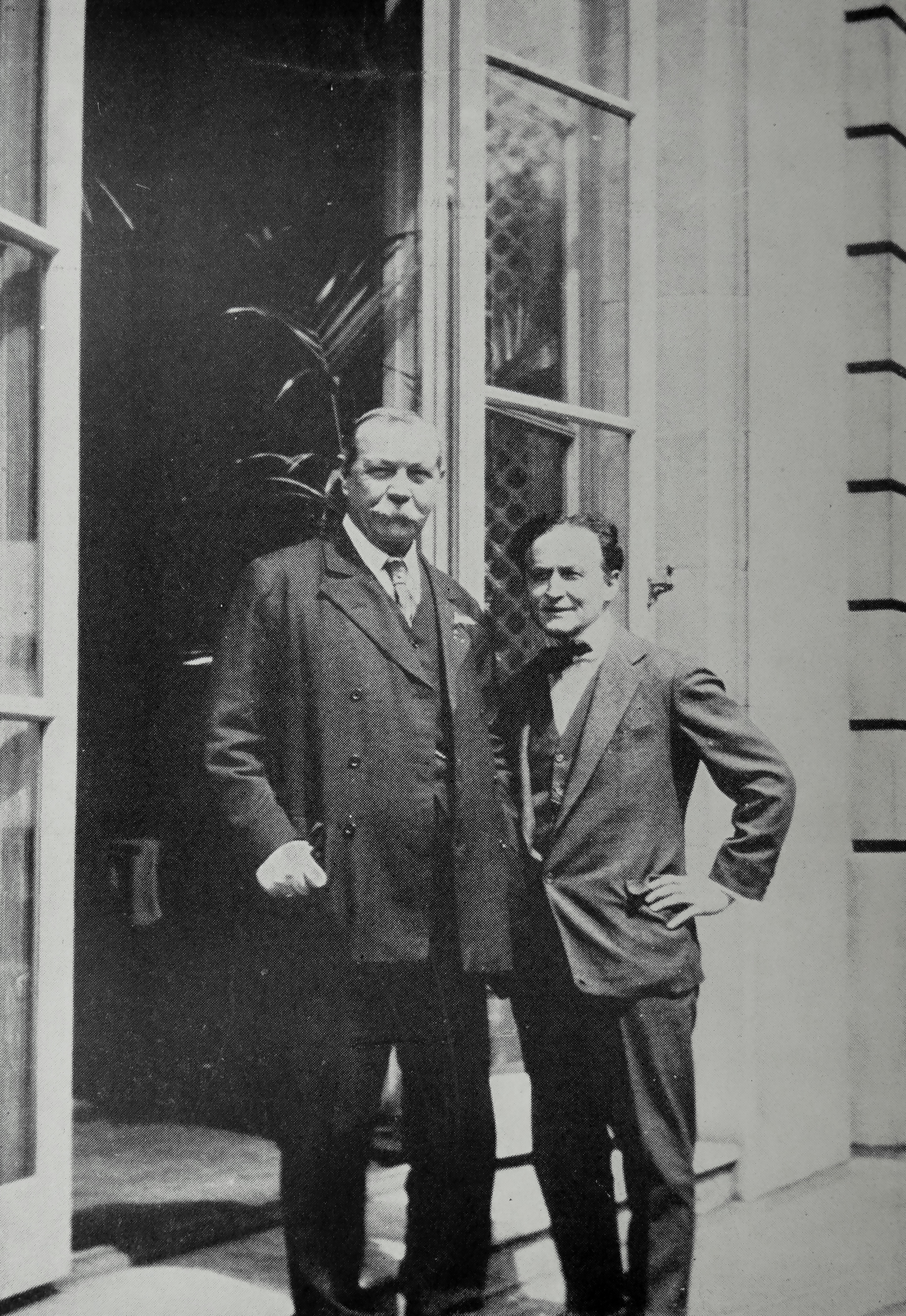
Photo of Arthur Conan Doyle and Harry Houdini in Houdini’s book “A Magician Among the Spirits” (1924)
Let’s not be hard on the victims of these scams and others. What can account for the rise in spiritualism? “The bloody death toll of WWI had left so many bereaved that people who had never been able to say goodbye to loved ones flocked to mediums in hopes of re-establishing contact,” writes Biography.com. “One of the key figures stirring the revival in Spiritualism was Sir Arthur Conan Doyle, who had himself lost a son, a brother and nine other relatives in the war. He became a proselytizer for Spiritualism, writing books about it, including two in 1918 alone, and became one of the public leaders of the movement.”
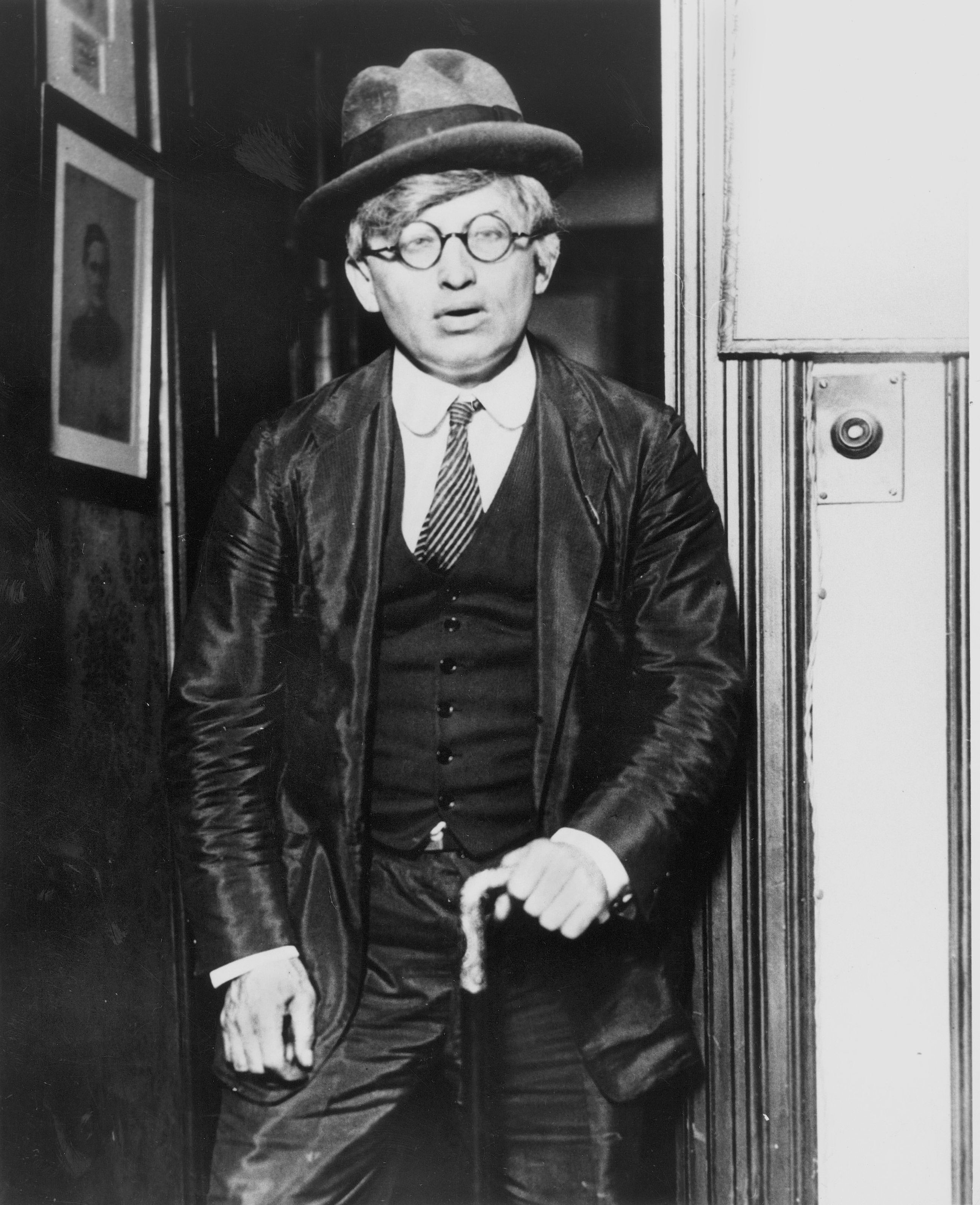
Houdini Disguised As An Old Man In Order To Enter The Home Of A Medium And Expose A Fake Seance, July 2, 1925.
Credulous fools, maybe. But emotion clouds even the most prosaic minds. Conan Doyle was himself the victim of an elaborate con.
When in Europe in 1919 finishing an engagement interrupted by the World War I was impressed by the eagerness of grief-stricken parents for the solace of a word from the boy who had passed on and my desire for the truth was renewed with fresh vigor. I am informed that so great has the “medium” craze become in Berlin that the grief-stricken residents have spent great sums of money in the hope of discovering mediums who will “guarantee them a glimpse behind the veil.” It is with
the deepest interest and concern that I have watched this great wave of Spiritualism sweep the world in recent months and realized that it has taken such a hold on persons of a neurotic temperament, especially those suffering from bereavement, that has become a menace to health and sanity resulting from strong belief in Spiritualism by neurotics the subject of a part of his annual report in 1920. He [Dr. Charles Mercier] says:“Those who had sustained bereavements during the war and bore them with equanimity in the days of crowded incidents and amidst the pressure of war activities, such as Red Cross and other work, find it much harder to bear up now, although time has elapsed. Some have broken down since the war came to an end. Many, as a solace to their feelings, have taken an interest in Spiritualism.”
Houdini did not consider Arthur Conan Doyle to be a safe judges, “whose opinion should be accepted on this difficult and important subject, in view of their bereavement and unconscious desires… The tricks the brain can play without calling in Spiritualistic aids are simply astounding, and only those who have made a study of morbid as well as normal psychology, realize the full truth of this.
Did Houdini prove his case and answer theirs and your concerns? Not exactly, no. After he died, many people tried to contact him, including his wife:
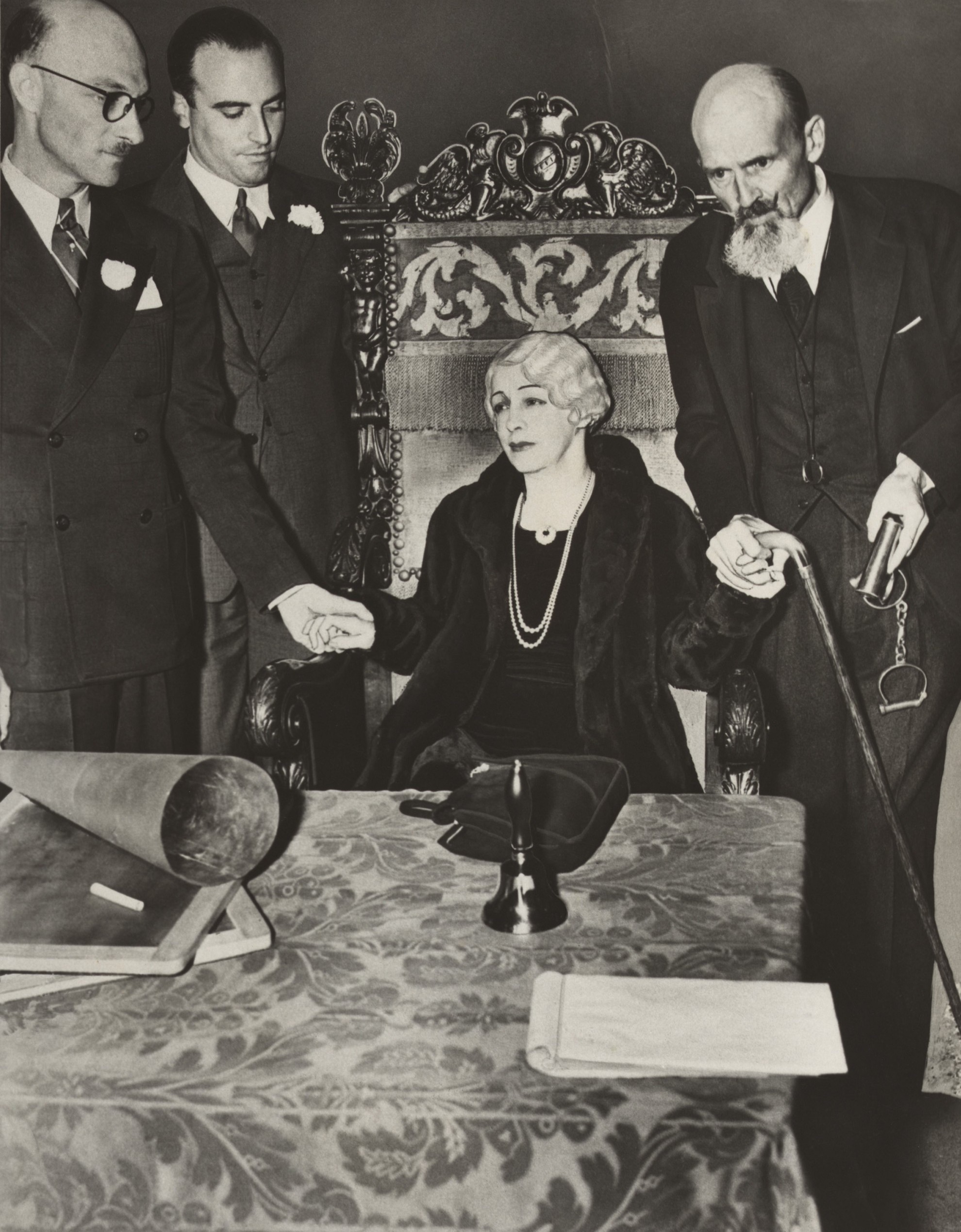
Mrs. Bess Houdini, widow of the great magician, sitting in a chair with her business manager, Edward Saint (to her left holding handcuffs), and others, during a seance, in an effort to contact the spirit of Harry Houdini. 1936
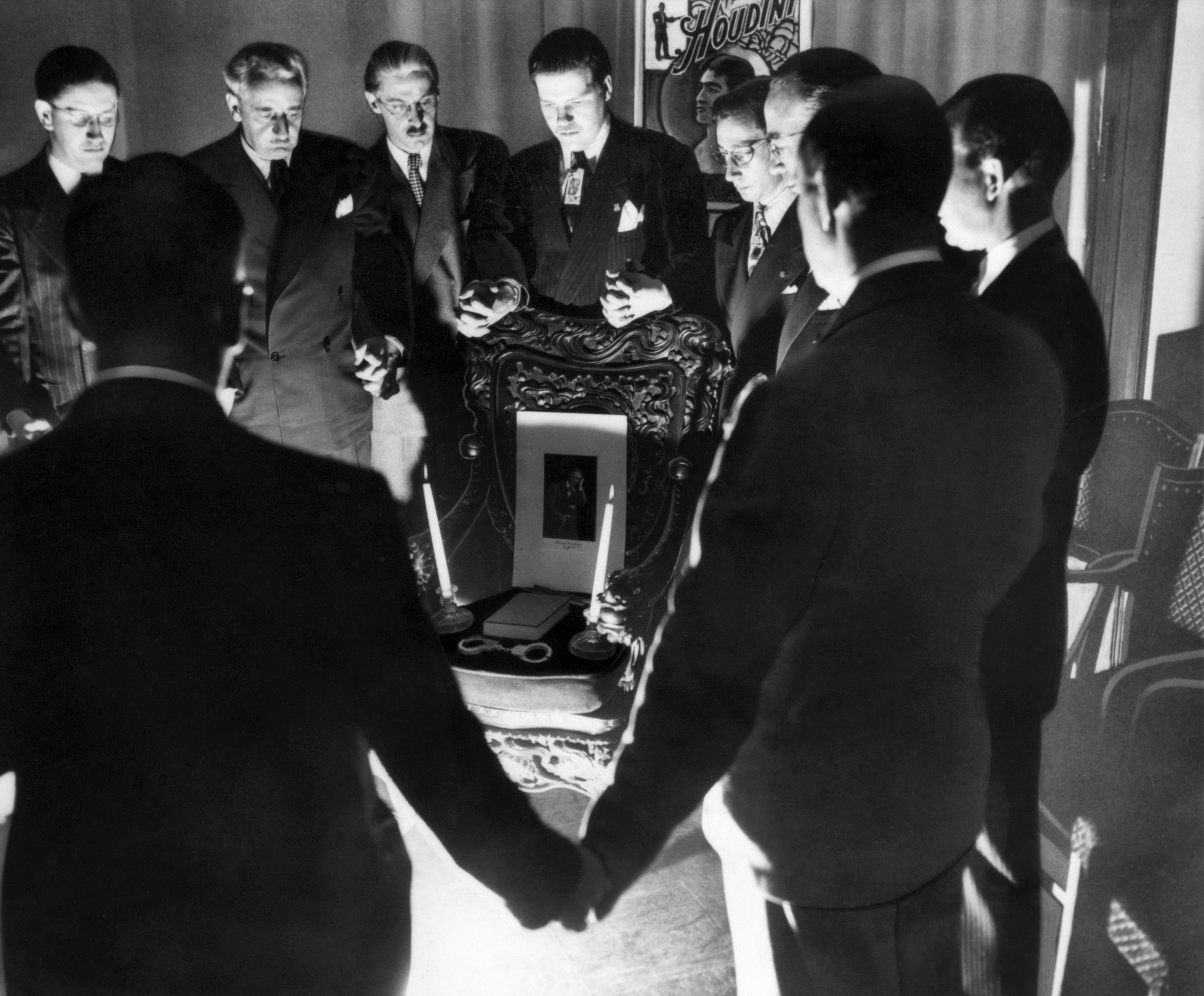
Houdini Seance, 1936. A Group Of Magicians Conducting A Seance In Detroit, Michigan, In An Attempt To Contact The Spirit Of Harry Houdini. Photograph, 31 October 1936.
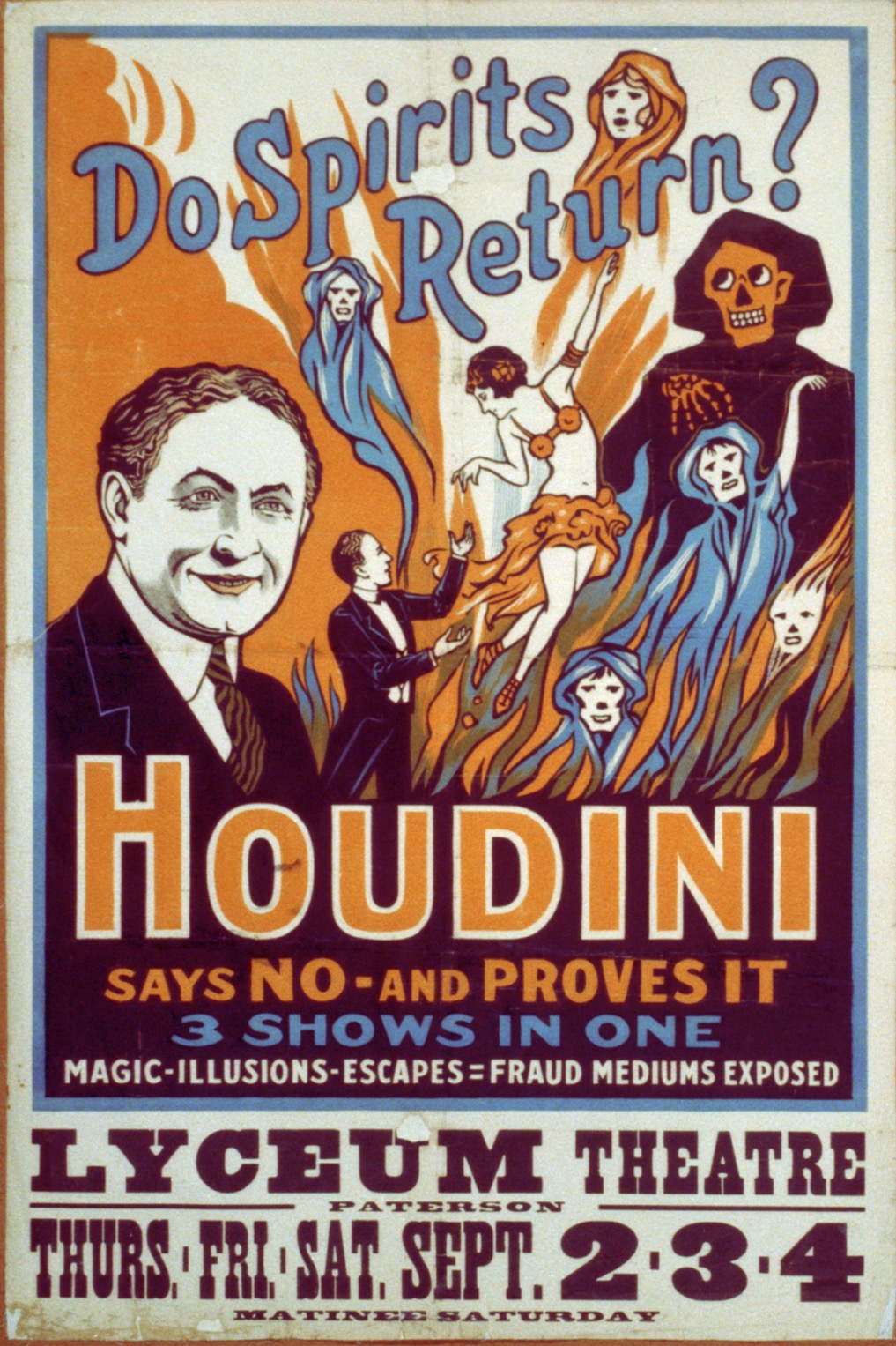
Would you like to support Flashbak?
Please consider making a donation to our site. We don't want to rely on ads to bring you the best of visual culture. You can also support us by signing up to our Mailing List. And you can also follow us on Facebook, Instagram and Twitter. For great art and culture delivered to your door, visit our shop.
